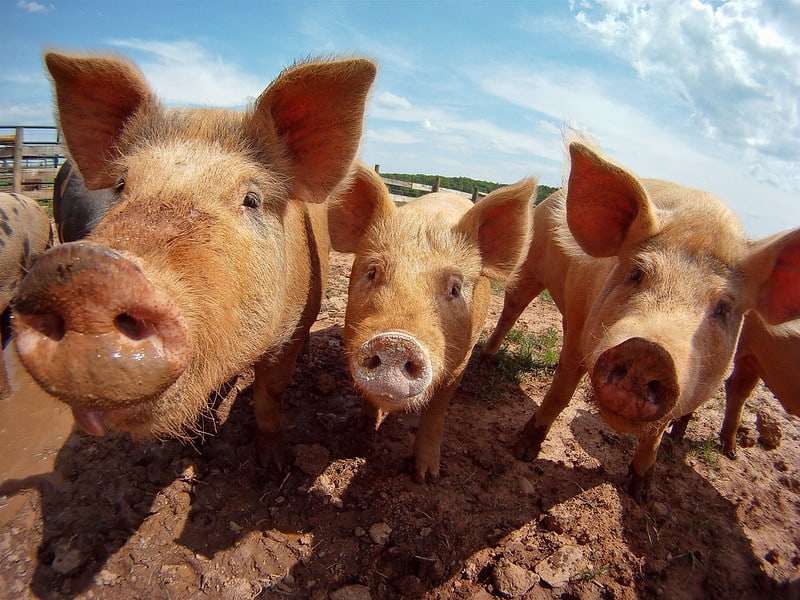When we think about pigs, we often picture them rolling in mud or eating at a trough. We also think of how badly they smell and if we have ever been around pigs, we know pigs have a very strong smell.
When we think of that smell, it is easy to imagine that pig poop probably produces gasses like methane.
Do pigs produce methane? Yes. Pigs do produce methane. It is one of the gasses they produce during their digestive process. After the pig eats, the food is broken down by its digestive system.
There are many steps to their digestive system. While the food is in the stomach, it is dissolved by stomach acid.
In addition to making the food ready to pass into the small intestine, this produces gasses that are expelled from the pig by farting or burping. One of these gasses is methane.
The EPA estimates pigs produce ethane at a rate of 1.5kg/head/year. By extension, a 2500-head facility would produce an average of 3.75 tons of methane per year.
Some pig farmers are looking into types of pig feed that have been designed in order to produce less methane when they are eaten.
One of the easiest changes to make is to reduce the amount of fiber in the pig’s diet, since it is fiber digestion that causes the most methane to be released after digestion.

How Much Do Pigs Contribute to Global Warming?
Greenhouse gasses influence global warming. These gasses affect global warming by trapping heat in our atmosphere.
The most common greenhouse gas is carbon dioxide (CO2), but greenhouse gasses also include methane and nitrous oxide.
Although there is less of it, methane is 35% more powerful as a greenhouse gas than carbon dioxide.
Although there is more CO2, it would therefore be easier and more environmentally beneficial to eliminate the methane. If we were able to do that, we might stave off global warming for the short term.
So, it is important to consider how much methane pigs – and each other animal – produces.
Despite the amount of methane they naturally produce, the EPA (Environmental Protection Agency) has determined that pigs’ methane production is not a major source of methane related to global warming.
However, waste management methods used by pig farmers will also produce methane. In the past few years, liquid waste management has increased in its production of methane.
The total amount of solid pig waste that can be converted to methane increased by 15% between 1990 and 2006.
Manure processing of pig waste equaled 34% of greenhouse gasses at that time.
The method pig handlers use to process pig waste is also an opportunity for them to decrease their contribution to greenhouse gasses.
Some pig handlers have opted to cover the containers in which the pig waste is stored.
Covering the containers (called lagoons) allows the methane to be captured and then burnt off.
By burning the methane, they can use it to power electric generators. The power produced by this method is called “green electricity”.
Some pig waste is used to fertilize crops. This type of fertilization also produces methane, but the EPA reports crop use of pig waste only contributes to 1.8% of greenhouse gasses.
In total, the amount of methane produced by pig waste management and crop fertilization was measured at 9%. This amount is a relatively small amount – according to the EPA.
Researchers at Duke University have found a way to turn pig waste into energy – thus reducing the amount of stored waste and the amount of waste that releases methane into the atmosphere.
The waste is placed into a manufactured anaerobic digestive chamber. The waste is digested using anaerobic bacteria, which produces methane like a pig’s digestive system does.
That methane is then burned by a turbine and turned into power. By doing this, that power can process the waste of the herd and contribute to powering some of the functions of the farm.
The digester not only turns the waste into power, but it cleans and releases the water from the pig waste – and then uses that water to irrigate the farm.
Do Chickens and Pigs Produce Methane?
As noted above, pigs do produce methane – in feces and burps. Chickens also produce some methane as a part of their digestive system, and the storage of chicken feces also produces methane. The method of handling their waste also produces methane.
However, the amount of methane associated with chickens is not considered to be significant.
As compared to pigs, chickens produce much less methane.
What Animal Produces the Most Methane?
Ruminant animals produce the most methane. Ruminants include cows, sheep, buffalo, goats, deer, and camels. Ruminants are animals that digest food with the help of a pouch in front of the stomach.
The pouch is called a rumen. The rumen ferments the animals’ food so they can digest it. The fermentation of food causes an increase in methane in these animals’ wastes.
Of all the ruminants, cows produce the most methane. The ruminant belches or farts 250-500 liters of methane daily. A cow produces methane due to its digestive process. It is also present in cow burps.
Do Pigs Produce as Much Methane as Cows?
No. Cows produce more methane than pigs. Pigs are not ruminants, so they produce less gas during their digestive process.
Conclusion: Do Pigs Produce Methane?
Pigs produce methane during their digestive process. Methane is also produced during pig waste management. Ruminant animals produce more methane than pigs; cows are the biggest contributors to methane.
Methane contributes to the amount of greenhouse gas production, which, in turn, increases global warming.
Methane is a lesser contributor to greenhouse gasses, and many companies and government agencies are hoping that by reducing the amount of methane in the air, they can positively impact global warming.
Some scientists are also finding ways to use methane as a power source.